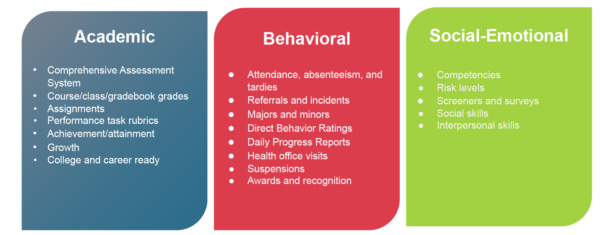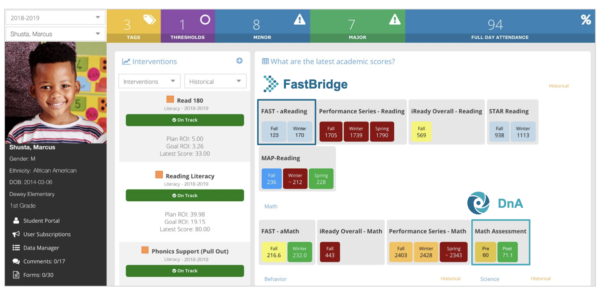Seeing the “Whole Child” Data Picture
Schools and districts are increasing their focus on data-driven, whole child supports. However, it can be confusing to determine which key data make up the “whole child data picture,” and how to make sense of those data points together.
What does supporting the whole child mean?
Although there are many ways to answer this question, ASCD defines the whole child in terms of five characteristics: healthy, safe, supported, challenged, and engaged. Many states and districts have adopted those domains in their approach to supporting the whole child. EdSurge Research noted that some educators think of educating the whole child as “a particular type of instruction or learning outcome, while for others, it was about creating environments that are conducive to learning.”
For our purposes, we’ll refer to supporting the “whole child” as an approach to supporting student success and well-being through many interconnected, data-informed lenses. It represents a shift away from a singular focus on the academic lens in terms of measuring student success and pinpointing student needs.
By working to support the whole child, educators are acknowledging a multitude of factors that impact student outcomes. Some of those factors have been tracked at local, state, and federal levels for a long time, like socioeconomic status or whether the student is an English Learner.
Others are newer to the landscape. For instance, educators now work to track whether the student has endured trauma, struggles with self-regulation, or lives with a parent suffering from drug or alcohol abuse.
Educators have long known that these types of factors impact student achievement. And now, shifts in policy and practice are prompting a new expectation to use whole child data. That is, to be able to record, codify, and visualize multiple factors—to make sense of those data, find patterns in them, and use them to make the best next decision for students—alongside academic data.
Naturally, with that shift, some questions arise: What data should we include in our whole child data collections? How can we get started in making connections between those different sources? What tools and resources are available to support us in this work? And many more.
Let's dig into an overview of key whole child data sources, including some that are newer to the educational landscape.
What is Whole Child Data?
Whole child data is typically conceptualized into three categories of data: academic, behavioral, and social-emotional. Each category encompasses a number of data sources. Some common examples for each are shown below and unpacked in our eBook.

Other Whole Child Data Sources and Data Lenses
There are other data sources and “lenses” that can be important to the whole child data picture—but might not fit neatly into those three categories. Here are a few examples:
Intervention Data
For students receiving an intervention, data about the intervention itself can be just as meaningful as progress monitoring data. When writing an intervention plan, educators articulate a targeted, specific, and measurable goal for the student (e.g., “Joelle will increase the number of words read correctly from 68 to 93 as measured by FastBridge CBMreading by May 1.”)
However, it’s just as important to articulate the educators’ plan to support Joelle using targeted, specific, and measurable terms. For instance, an intervention plan might state: “Ms. Harmon will work with Joelle using the Read Well intervention program 2 times per week for 20 minutes in a small group during Group Time in class. Progress is monitored with FastBridge CBMreading every two weeks.”
It’s important to then document data about the intervention’s actual implementation to determine whether it was implemented with fidelity. This includes:
- Attendance and Engagement: How often did the student actually receive the intervention? If the student was absent from an intervention, why? If the student was present, was he or she engaged?
- Frequency and Duration: Was the intervention implemented for the prescribed amount of time? Was it implemented as often as prescribed?
- Setting: Did the intervention take place in the location specified (e.g., small group in classroom vs. small group pulled out)?
- Interventionist: Was the intervention implemented by the individual who was named in the student's plan? If so, has he or she been trained in using the intervention at hand?
School Climate and Culture
Definitions for school climate and culture can vary. The National School Climate Center defines school climate as “the quality and character of school life.” The Reference Manual on Making School Climate Improvements notes that “school climate reflects how members of the school community experience the school, including interpersonal relationships, teacher and other staff practices, and organizational arrangements. School climate includes factors that serve as conditions for learning and that support physical and emotional safety, connection and support, and engagement.”
Cohen, Pickeral, and McCloskey wrote that “in the last 30 years, a growing body of research has confirmed the importance of the learning climate for children and adolescents. Compelling empirical research shows that a positive and sustained school climate promotes students' academic achievement and healthy development. Not surprisingly, a positive school climate also promotes teacher retention, which itself enhances student success (Center for Social and Emotional Education, 2007; Cohen, McCabe, Michelli, & Pickeral, in press; Zins, Weissberg,Wang, & Walberg, 2004).”
Trauma
Trauma is the result of an acute crisis event or chronic adverse experiences. A 2007 study by Copeland, Keller, Angold and Costello reported that “more than two thirds of children reported at least 1 traumatic event by 16 years of age.” Traumatized youth are often focused on survival, thereby affecting their ability to learn, socialize, and develop the proper skills that are needed to thrive. Physical changes occur to the brains of traumatized youth, and these students are truly functioning in a “fight or flight” mode. Toxic stress, caused by trauma, has now been proven to alter students’ brain chemistry which can alter ability to stay focused, complete a task, stay organized, or remember instructions (Harris & Ziegler, 2018).
Knowing that a student has endured trauma provides important context for understanding student struggles and supporting their needs. The fact that the national rate of student trauma is so high can also inform a district’s programming and professional development needs at a Tier 1 universal level.
Mental Health
In the Morbidity and Mortality Weekly Report published by the CDC, Perou, R., et. al. define mental health in childhood as “the achievement of development and emotional milestones, healthy social development, and effective coping skills, such that mentally healthy children have a positive quality of life and can function well at home, in school, and in their communities.”
While some feel that SEL does not encompass mental health conditions such as depression, anxiety disorders, post-traumatic stress disorder, obsessive-compulsive disorder, and bi-polar disorder, there is more common agreement that SEL programs can provide strong support for students with diagnosed psychiatric attention deficit hyperactivity disorder (ADHD) and intermittent explosive disorder (Balow, 2018).
The 2017-2018 National Survey of Children's Health found that 21.9% of children ages 3-17 years have one or more reported mental, emotional, developmental or behavioral problem, and/or qualifies on CSHCN Screener emotional, behavioral or developmental criteria. Moreover, the 2017 High School Youth Risk Behavior Survey found that 7.4% of students had attempted suicide one or more times during the 12 months before the survey.
Ensuring the right people within a school have an awareness of the mental health needs of their students can have important implications for how we interpret student needs, connect students with resources, and approach providing support.

As we look into the coming year, it is more important than ever to equip educators to take a whole child approach to supporting student success. To dive deeper into the key data that make up the whole child data picture—and how to make sense of those data points together—check out our new eBook, "The Whole Child."
*****
Illuminate Education partners with K-12 educators to equip them with data to serve the whole child and reach new levels of student performance. Our solution brings together holistic data and collaborative tools and puts them in the hands of educators. Illuminate supports over 17 million students and 5200 districts/schools.
Ready to discover your one-stop shop for your district’s educational needs? Let’s talk.


